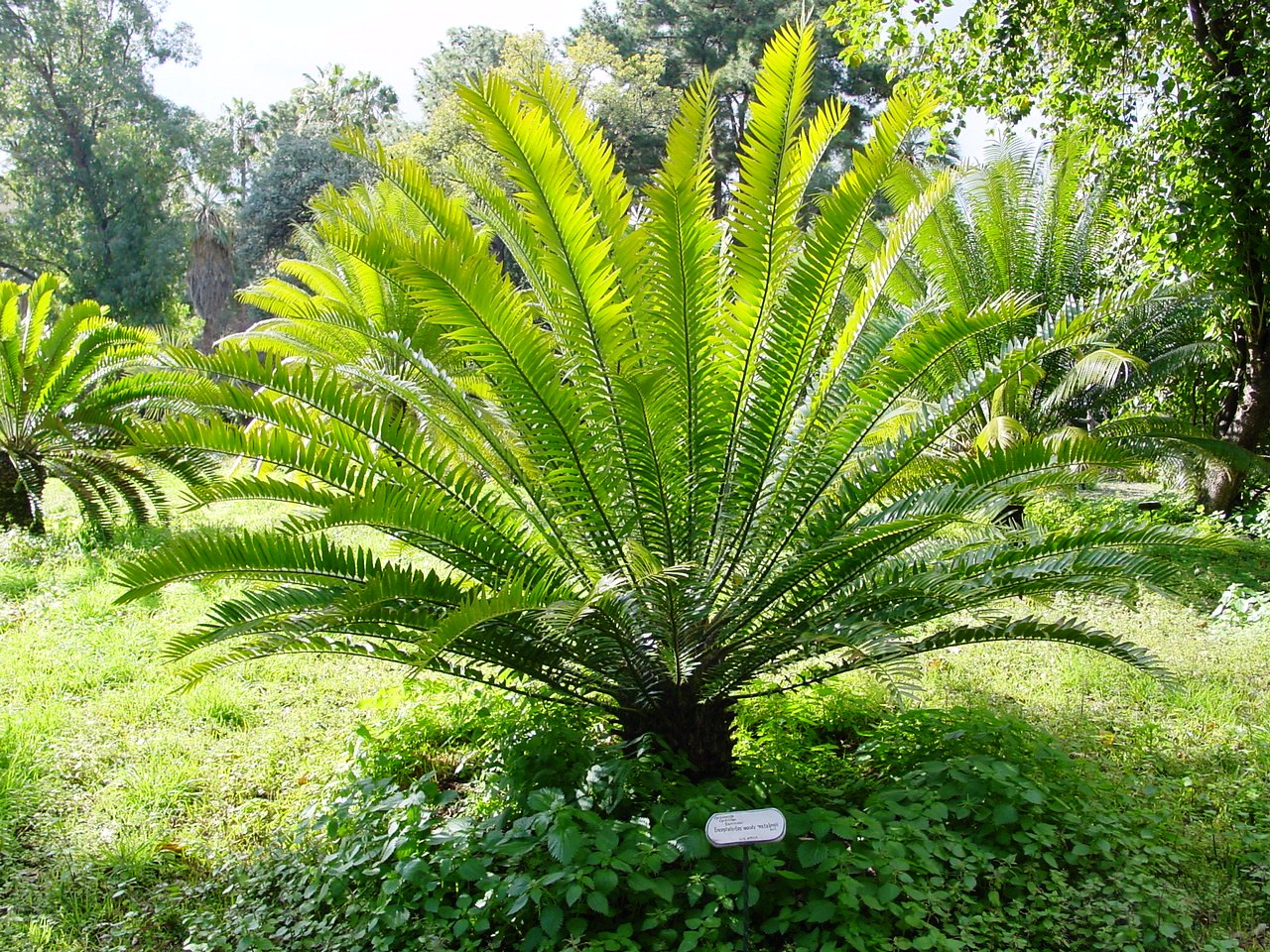Encephalartos
The bread cycads ( Encephalartos ) are a genus of cycads in the family of Zamiaceae. The genus is limited by the diffusion to Africa. All about 65 species of the genus are at risk in the portfolio. The genus is listed fully in Appendix I of the CITES Convention ( CITES).
Description
The shoot axis is formed underground or aboveground stem. Underground it reaches a diameter of 15 centimeters. Tree -like stems are up to 15 meters high. The stems are cylindrical and pachycaul. Many species form at the base of the trunk additional rung so old plants can form a large clump. Otherwise, the branch is extremely rare.
The leaves are in schraubiger arrangement at the end of the stem. Between the foliage leaves are formed Cataphylle are simply pinnate and very variable. The length ranges from 60 to 600 inches, the surface is dull to shiny, the color ranges from blue-gray to yellow green to dark green. The rachis is curved inwardly curved or straight outwards sharply bent up. The leaflets are often almost perpendicularly from the rachis. They are narrow to broad, unarmed or spiny. The lower leaflets are often transformed entirely to thorns
The female cones are individually or up to eight at a plant. The size is 30 cm long and 15 cm wide and 80 cm long and 40 cm wide. They are sessile or stalked, erect or nodding. The color ranges from blue-gray over light and dark green to brown, maroon, yellow, orange, pink and red. The surface of the pin stripped smooth, spotty or wrinkled, hairless hairy up close. The sporophylls are simple, fleshy, and bear on the adaxial side two ( rarely three ) orthotropic ovules whose micropyle faces the pin axis.
The male cones are more numerous than the females. The stems are usually longer than in the female, otherwise similar to the female cones. On each sporophyll sit numerous pollen sacs on the underside ( abaxial ). This open with slots. The pollen is boat-shaped ( cymbiform ) and has a germ- fold ( monosulcat ).
The seeds are oblong to ellipsoidal, the sarcotesta is fleshy and red, yellow, orange or brown color. The endosperm is habloid and is formed by the female gametophyte. The embryo has two cotyledons, which are usually connected at the top, and a long, spiral suspensor. Germination runs kryptokotylar.
The chromosome number is 2n = 18
Dissemination and locations
The bread cycads are restricted to Africa. The northern limit of their occurrence extends from the Sudan across the Central African Republic, Nigeria to Ghana. In the south, it occurs to South Africa. The focus in Eastern and Southern Africa, on the west coast occurs only Encephalartos barteri.
The sites are extremely diverse, bread cycads grow in deserts, savannas and forests, but they are missing in rainforest. They come from sea level up to 2400m before.
System
The genus Encephalartos alone forms the subtribe Encephalartinae, and together with the Subtrubs Microzamiinae the tribe Encephalarteae. Within the genus 2002 63 species were distinguished, but it has been calculated with the description of a number of new types.
The species described through 2002 are:
- Encephalartos aemulans
- Encephalartos altensteinii
- Encephalartos aplanatus
- Encephalartos arenarius
- Encephalartos barteri
- Encephalartos brevifoliolatus
- Encephalartos bubalinus
- Encephalartos caffer
- Encephalartos cerinus
- Encephalartos chimanimaniensis
- Encephalartos concinnus
- Encephalartos Cupidus
- Encephalartos cycadifolius
- Encephalartos delucanus
- Encephalartos dolomiticus
- Encephalartos dyerianus
- Encephalartos equatorialis
- Encephalartos eugene - maraisii
- Encephalartos ferox
- Encephalartos Friderici - guilielmi
- Encephalartos ghellinckii
- Encephalartos gratus
- Encephalartos heenanii
- Encephalartos hildebrandtii
- Encephalartos hirsutus
- Encephalartos horridus
- Encephalartos humilis
- Encephalartos inopinus
- Encephalartos ituriensis
- Encephalartos kisambo
- Encephalartos laevifolius
- Encephalartos lanatus
- Encephalartos latifrons
- Encephalartos Laurentianus
- Encephalartos lebomboensis
- Encephalartos lehmannii
- Encephalartos longifolius
- Encephalartos macrostrobilus
- Encephalartos manikensis
- Encephalartos marunguensis
- Encephalartos middelburgensis
- Encephalartos msinganus
- Encephalartos munchii
- Encephalartos natalensis
- Encephalartos ngoyanus
- Encephalartos nubimontanus
- Encephalartos paucidentatus
- Encephalartos poggei
- Encephalartos princeps
- Encephalartos pterogonus
- Encephalartos relictus
- Encephalartos schaijesii
- Encephalartos schmitzii
- Encephalartos sclavoi
- Encephalartos senticosus
- Encephalartos septentrionalis
- Encephalartos tegulaneus
- Encephalartos transvenosus
- Encephalartos trispinosus
- Encephalartos turneri
- Encephalartos umbeluziensis
- Encephalartos villosus
- Encephalartos whitelockii
- Encephalartos woodii
Botanical history
The genus Encephalartos were first described by the German botanist Johann Georg Christian Lehmann in 1834. Before all cycads were classified in the genus Zamia. The genus name means something like bread in the head and alludes to the use of ordinary marrow as a source of starch on. Lehmann also had the Australian species of the family belongs to the genus Encephalartos, which have now been transferred to their own genera Macrozamia and Lepidozamia.
Use
Various species of the genus have been used as a source of starch. Both the seeds as well as the marks were - mainly in times of need - processed into flour. The toxins were removed by repeated washing.
Several species are grown mainly in their natural range as garden ornamentals, particularly in South Africa.
Documents
- Loran M. Whitelock: The Cycads. Timber Press, Portland, OR 2002, ISBN 0-88192-522-5, pp. 174 f (characteristics, distribution, use ).
- KD Hill: genus Encephalartos Cycad Pages to the Royal Botanic Gardens Sydney accessed 22 April 2008 ( features).







.jpg)

